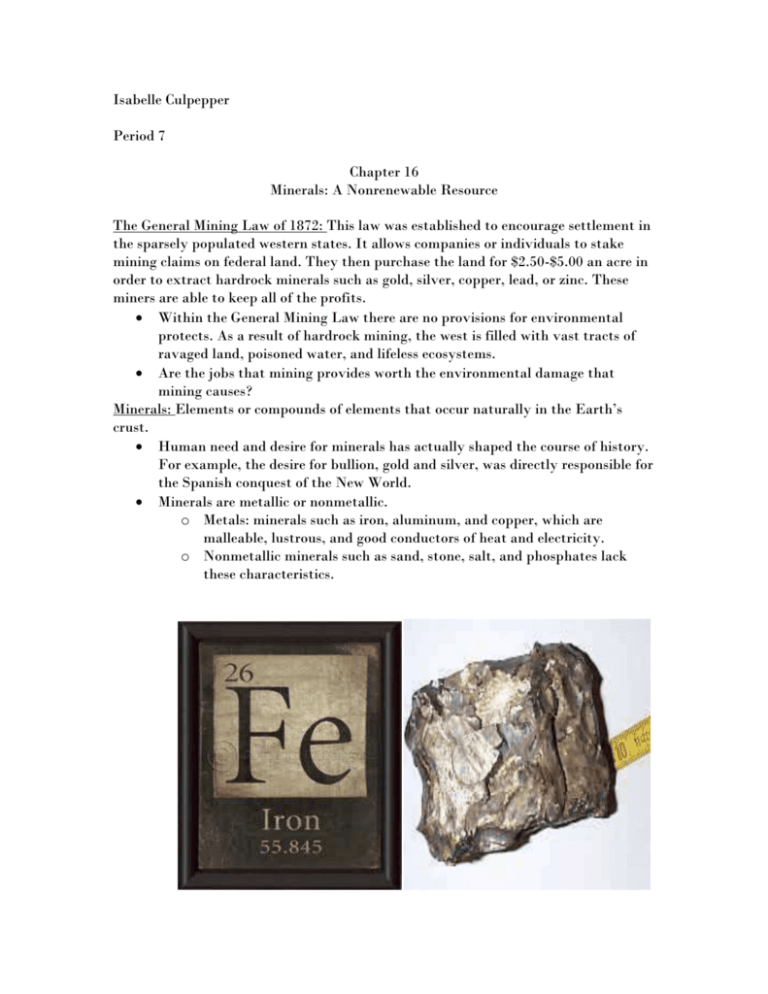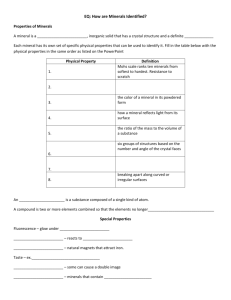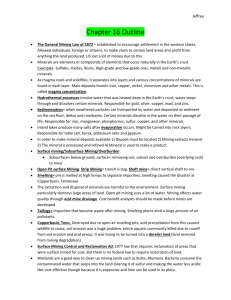Isabelle Culpepper Period 7 Chapter 16 Minerals: A Nonrenewable
advertisement

Isabelle Culpepper Period 7 Chapter 16 Minerals: A Nonrenewable Resource The General Mining Law of 1872: This law was established to encourage settlement in the sparsely populated western states. It allows companies or individuals to stake mining claims on federal land. They then purchase the land for $2.50-$5.00 an acre in order to extract hardrock minerals such as gold, silver, copper, lead, or zinc. These miners are able to keep all of the profits. Within the General Mining Law there are no provisions for environmental protects. As a result of hardrock mining, the west is filled with vast tracts of ravaged land, poisoned water, and lifeless ecosystems. Are the jobs that mining provides worth the environmental damage that mining causes? Minerals: Elements or compounds of elements that occur naturally in the Earth’s crust. Human need and desire for minerals has actually shaped the course of history. For example, the desire for bullion, gold and silver, was directly responsible for the Spanish conquest of the New World. Minerals are metallic or nonmetallic. o Metals: minerals such as iron, aluminum, and copper, which are malleable, lustrous, and good conductors of heat and electricity. o Nonmetallic minerals such as sand, stone, salt, and phosphates lack these characteristics. All minerals have precise chemical compositions. o Sulfides: mineral compounds in which certain elements are combined chemically with sulfur. o Oxides: mineral compounds in which elements are combined chemically with oxygen. o Rocks are naturally formed aggregates, or mixtures, of minerals and have varied chemical compositions. An ore is a rock that contains a large enough concentration of a particular mineral to be profitably mined and extracted. High-grade ores contain relatively large amounts of particular minerals, whereas low-grade ores contain lesser amounts. Abundance of a mineral does not mean that it is easily accessible or profitable to extract. Additionally, mineral deposits in Earth’s crust are distributed unevenly, which can lead to international arguments about the valuable minerals. Concentrations of minerals within Earth’s crust are the result of natural processes: Magmatic Concentration: Magma cools and solidifies deep in Earth’s crust where it often separates into layers, with the heavier iron- and magnesiumcontaining rock settling on the bottom and the lighter silicates rising to the top. Varying concentrations of minerals are often found in different rock layers. This layering is responsible for some deposits of iron, copper, nickel, chromium, and other metals. Hydrothermal Processes: Water that was heated deep in Earth’s crust seeps through cracks and fissures and dissolves certain minerals in the rocks. The minerals are then carried along in the hot water solution. The dissolving ability of water is greater if chlorine or fluorine is present because these elements react with many metals to form salts that are soluble in water. When the hot solution encounters sulfur, a chemical reaction between the metal salts and the sulfur produces metal sulfides. These sulfides are not soluble in water, so they form deposits by settling out of the solution. This process is responsible for deposits of minerals such as gold, silver, copper, lead, and zinc. Sedimentation: Weathered rock particles are transported by water and deposited as sediment on riverbanks, deltas, and the sea floor. During transport, certain minerals in the weathered particles dissolve in the water, and later settle out of the solution. When warm river water meets cold ocean water, settling occurs because less material deposits dissolve in cold water than in warm water. Sedimentation has formed important deposits of iron, manganese, phosphorus, sulfur, copper, and other minerals. Evaporation: When significant amounts of dissolved material accumulate in inland lakes or seas that have no outlet, or a small outlet, to the ocean they are left behind with evaporation. Over time the salts may be covered with sediment and incorporated into rock layers. Evaporation has formed deposits of common table salt, borax, potassium, salts, and gypsum. Process of making mineral deposits available for human consumption: Discovering Mineral Deposits: Aerial and satellite photography, aircraft and satellite instruments, and seismographs can reveal information about certain mineral deposits. Once geologists examine this data, mining companies drill for samples. *Deposits on the ocean floor can be estimated using sophisticated computer analysis. Extracting Minerals: Depending on depth, surface mining (the extraction of mineral and energy resources near Earth’s surface by first removing soil, subsoil, and overlying rock strata) or subsurface mining (the extraction of mineral and energy resources from deep underground deposits) can be used. With all types of extraction, overburden (soil and rock overlying a useful mineral deposit) must be removed. With surface mining, it is possible to conduct open-pit surface mining, in which a giant hole or quarry is dug. It is also possible to conduct strip mining, in which a trench is dug to extract minerals. A new trench is dug parallel to the old one, so the overburden from the new trench is put into the old trench, creating a hill of loose rock called a spoil bank (a hill of loose rock created when the overburden from a new trench is put into the already excavated trench during strip mining). Subsurface mining is underground, so it can be done through shaft mining, which is a direct vertical shaft to the vein of ore. The ore is broken up underground and then sent to the surface in buckets. On the other side, is slope mining, which means using a mine with a slanting passage tat makes it possible to haul the broken ore our of the mine in cars rather than hoisting it up with buckets. Subsurface mining disturbs the land less than surface mining, but it is more expensive and hazardous for miners. Processing Minerals: Often involves smelting, or the process in which ore is melted at a high temperature to separate impurities from the molten metal. Metals can be smelted using a blast furnace, which adds metals to the top of the furnace, while heated air or oxygen is added at the bottom. The iron ore reacts with coke to form molten iron and carbon dioxide. The limestone reacts with impurities in the ore to form a molten mixture called slag. Both substances collect at the bottom, but the slag floats on top because it is less dense than iron. The slag is then disposed of. All of these steps harm the environment. Mining disturbs and damages the land, while processing and disposal pollutes the air, soil, and water. Environmental Impacts: Mining disturbs large areas of land because mining destroys vegetation, so it is prone to erosion. Wind erosion causes air pollution and water erosion pollutes nearby waterways and damages aquatic habitats. Open-pit mining uses huge quantities of water. When miners hit the water table, they must pump out the water to keep the pit dry. Environmentalists and others would like miners to reinject the water into the ground after they have pumped it out. Mining affects water quality. Rocks rich in minerals often contain high concentrations of heavy metals. Rainwater can seep through sulfide minerals in mine wastes, which produces sulfuric acid, which in turn dissolves into other toxic substances. This is called acid mine drainage when the toxins make their way to nearby lakes and streams. Before mining it is suggested that companies conduct a cost-benefit analysis that includes the benefits of the mine in dollar terms versus the benefits in dollar terms of preserving the land intact for wildlife habitat, indigenous people, watershed protection, and recreation. Mineral Facts: About 80% or more of mined ore consists of impurities that become wastes after processing. These wastes, or tailings, are usually left in giant piles on the ground or in ponds near the processing plants. The toxic tailings contaminate the air, soil, and water. Smelting plants can emit large quantities of air pollutants during mineral processing. Unless pollution-control devices are added to smelters, the sulfur it produces escapes into the atmosphere to form sulfuric acid. Additionally, smelters emit hazardous liquid and solid wastes that can cause soil and water pollution. One huge problem for the environment is that it takes a large amount of energy to mine and refine minerals, particularly if they are being refined form low-grade ore. Copper Basin, Tennessee: Example of environmental degradation caused by smelting. This area was a forest, but it is now comprised solely of red hills with deep ruts gouged into them. No plant or animal species can inhabit this land. Copper ore was discovered here in the 19th century. The area was destroyed by deforestation and acid precipitation after a few short years of mining. Soil erosion cut massive gullies in the gently rolling hills because there were no plants to hold it in place. The TVA and US Soil Conservation Service planted trees and grasses, but most of them died. Restoration of Mining Lands: Land can be reclaimed or restored when the mine is no longer profitable to operate. Goals: prevent further degradation and erosion of the land, eliminate or neutralize local sources of toxic pollutants, and make the land productive for purposes other than mining. Lands destroyed by mining are called derelict lands. After grading the derelict land, plants that can tolerate the toxins in the soil must be planted. The Surface Mining Control and Reclamation Act of 1977 requires reclamation of areas that were surface mined for coal. Creative approaches to Cleaning up Mining Areas: Wetlands can be established to trap sediments and pollutants, so water quality of downstream areas is improved. A series of wetlands is the most effective way to clean up this area. However, artificial wetlands take 50 to 100 years to neutralize acid enough for life to return to water sources downstream form acid mine damage. Dumping cow manure onto mining lands causes the pH of the mine drainage water to increase as bacteria consume the manure. Phytoremediation is the use of specific plants to absorb and accumulate toxic materials such as nickel from the soil. The nickel can then be taken from the plants’ ashes after they are burned and it can be reused. Developed versus Developing: Mining plays a large part in developing countries’ economies because developed countries have exhausted all of their mineral resources. However, developing countries are not able to take measures to prevent the environmental damage that is caused by mining. Additionally, foreign companies often have mining interests in developing countries. Developed countries had vast resources that allowed them to industrialize, but due to industrialization process, they depleted their domestic reserves of minerals, so many developed nations must turn to developing countries for mineral resources. Many industrialized nations become dependent upon a few countries for the supplies of a necessary mineral, like chromium, which has a variety of uses. Many industrialized nations have stockpiled important minerals to reduce their dependence on potentially unstable suppliers. The US and others have stockpiles of strategic minerals (titanium, tin manganese, chromium, platinum, and cobalt) because these metals are important for industry and defense. Will we run out of Important Minerals? Mineral Reserves: Mineral deposits that have been identified and are currently profitable to extract. Mineral Resources: Any undiscovered mineral deposits or known deposits of low-grade ore that are currently unprofitable to extract (may be profitable to extract in the future). The combination of a mineral’s reserves and resources is its total resources or world reserve base. Estimates of mineral reserves and resources fluctuate with economic, technological, and political changes. It is extremely difficult to forecast future mineral supplies. Due to new discoveries of major deposits, plastics, synthetic polymers, ceramics, and a global economic slump all resulted in a lower consumption of minerals. Most experts think mineral supplies, both metallic and nonmetallic, will be adequate during the 21st century. Additionally, they think that prices of even relatively plentiful minerals will increase. Many known mineral reserves have not yet been exploited. As new technologies become available, increasing pressure will be exerted to mine in northern California, Siberia, and Antarctica. Some of the ore deposits in Siberia have unusual combinations of minerals, which will require new technologies. Undiscovered mineral deposits may exist in developing countries where detailed geologic surveys are not yet available. Minerals in Antarctica: The Antarctic Treat of 1961 limits activity in Antarctica to peaceful uses such as scientific studies, since no one owns Antarctica. The Environmental Protection Protocol to the Antarctic Treaty or the Madrid Protocol was established in 1990, and it designates Antarctica and its marine ecosystem as a “natural reserve dedicated to peace and society.” Polar regions are extremely vulnerable to human activities. Antarctica plays a crucial role in regulating many aspects of the global environment, so it is necessary to be careful. Minerals from the Ocean: Minerals could be extracted from seawater, or the sea floor may be mined where minerals have accumulated in the loose ocean sediments or near underwater volcanoes. Seawater contains many different dissolved materials, but they are of a very low concentration. Large deposits of minerals lie on the ocean floor. However, dredging minerals from the ocean floor would hurt sea life, and the current market value for these minerals would not cover the expense of obtaining them using existing technologies. Also, it is not clear which country has the legal right to minerals in international waters. The U.N. Convention on the Law of the Sea (UNCLOS), which became effective in 1994, is generally considered a constitution for the ocean that protects its resources. The provisions of UNCLOS are not binding for territorial waters, only for international waters, so there is no legal reason to block seabed mining. Seabed miners acknowledge that some organisms will die during the mining process. Ocean mining should become technologically feasible and profitable sometime during the 21st century. Advanced Mining and Processing Technologies: As minerals grow scarcer, economic and political pressure to exploit low-grade ores will increase. Future technology may make this less expensive because it will be more energy-efficient. Biomining: In some cases, it is possible to use microorganisms to extract minerals form low-grade ores. Finding Mineral Substitutes: Economics partly drive the search for substitutes because they are one way to cut production costs. It is cheaper to substitute an abundant material for an expensive or scarce one. Substitution is not a cure-all as some minerals have no known substitutes. Mineral Conservation: The reuse (conservation of resources in used items by using them over and over again) is one way to extend mineral resources. This type of conservation reduces mineral consumption and pollution. Reusing a product expends less energy than recycling it. Reuse also reduces litter and solid waste. In recycling, used items can be conserved by being converted into a new product. Recycling of certain minerals is a common practice in the industrialized world. Recycling saves unspoiled land from the disruption of mining, reduces the amount of solid waste that must be disposed, and decreases energy consumption and pollution. It takes approximately six weeks for a used can to be melted, re-formed, filled, and put back on a supermarket shelf. We can reduce mineral consumption by becoming a low-waste society. We consume fewer resources if the products are durable and repairable. Increasingly, manufacturers are finding that the waste products from one manufacturing process can become the raw materials for another industry. Sustainable manufacturing is a manufacturing system based on industrial waste minimization. It requires that companies provide information about their waste products to other industries. Dematerialization is the decrease in weight of products over time. However, smaller and lighter products may be of lower quality. Although the weight of materials being used to make each item has decreased, the number of such items being used in a given period may have actually increased.






